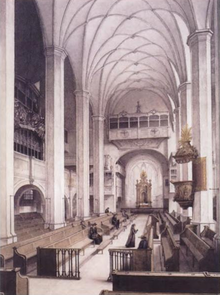Schauet doch und sehet, ob irgend ein Schmerz sei, BWV 46
|
Schauet doch und sehet, ob irgend ein Schmerz sei BWV 46 |
|
|---|---|
| Church cantata by J. S. Bach | |

Thomaskirche, Leipzig
|
|
| Related | Qui tollis peccata mundi of the Mass in B minor |
| Occasion | Tenth Sunday after Trinity |
| Performed | 1 August 1723: Leipzig |
| Movements | 6 |
| Bible text | |
| Chorale | by Johann Matthäus Meyfart |
| Vocal |
|
| Instrumental |
|
Schauet doch und sehet, ob irgend ein Schmerz sei (Behold and see, if there be any sorrow),BWV 46, is a church cantata by Johann Sebastian Bach. He composed it in Leipzig for the tenth Sunday after Trinity and first performed it on 1 August 1723.
The cantata is part of Bach's first annual cycle of cantatas, which he began when he took up office as Thomaskantor in May 1723. The topic is based on the prescribed reading from the gospel of Luke, Jesus announcing the destruction of Jerusalem and cleansing of the Temple. The librettist is unknown. The cantata is structured in six movements: two choral movements frame a sequence of alternating recitatives and arias. The opening movement is based on a verse from the Book of Lamentations, a lament of the destructed Jerusalem, related to the announcement from the gospel. The text moves from reflecting God's wrath in the past to the situation of the contemporary Christian. The closing chorale, a stanza from Johann Matthäus Meyfart's hymn "O großer Gott von Macht", is a prayer culminating in the thought "do not repay us according to our sins".
The cantata is scored for three vocal soloists (alto, tenor and bass), a four-part choir, a slide trumpet, two recorders, two oboes da caccia, strings and basso continuo. This is an unusually rich instrumentation for an ordinary Sunday. Bach created in the opening chorus an unusual "uncompromising"fugue for up to nine parts. The bass aria with an obbligato trumpet, depicting God's wrath compared to a thunderstorm, has been regarded as "more frightening" than any contemporary operatic 'rage' arias. The closing chorale is not the usual simple four-part setting, but includes instrumental interludes reminiscent of motifs used before.
...
Wikipedia
